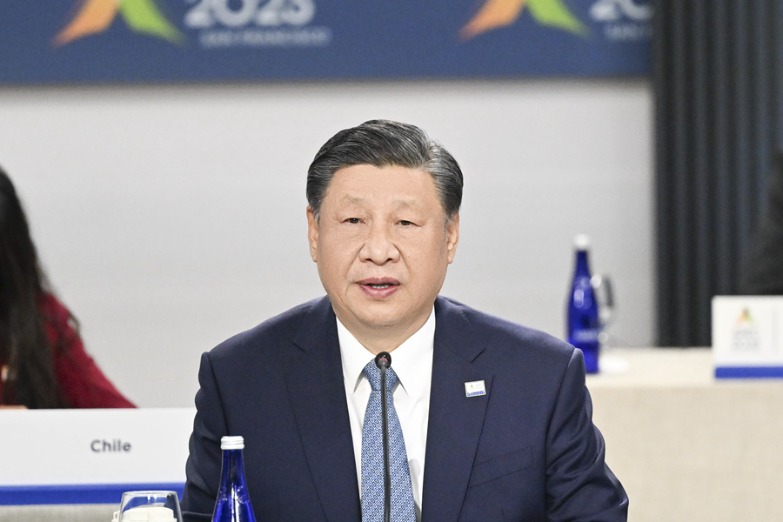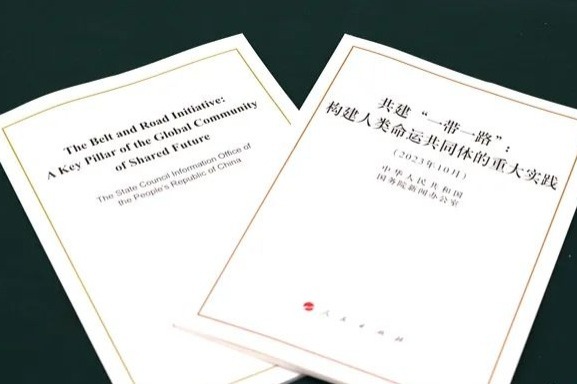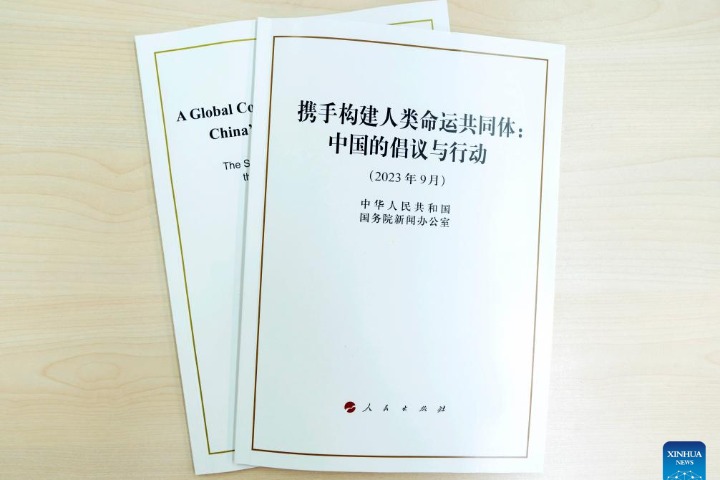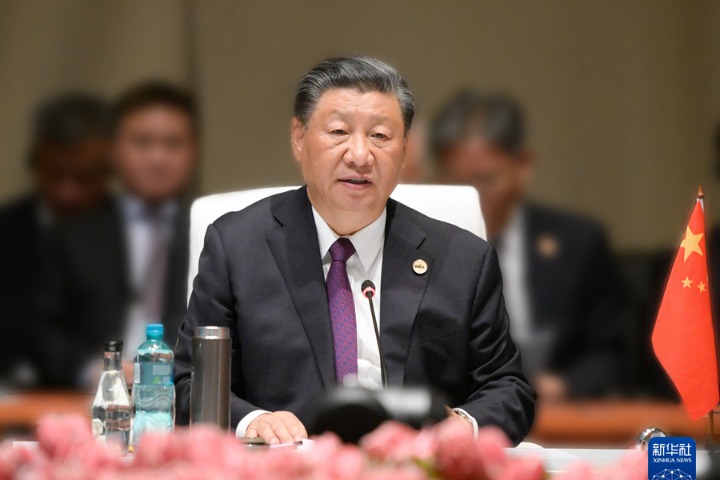西藏和平解放与繁荣发展(双语全文)
新华网 2021-05-21 16:00

三、社会制度的历史跨越
III. Historic Changes in Society
西藏民主改革是西藏人民的愿望,但何时改革须根据西藏实际。1956年,中央人民政府作出“六年不改”的决定。然而,西藏上层统治集团的一些人企图永远保留封建农奴制,并在1959年3月发动全面武装叛乱。中央人民政府在平息叛乱的同时,在西藏开展了彻底废除封建农奴制的民主改革运动,从根本上改变了西藏旧的社会制度,并为西藏自治区的成立奠定了坚实的基础。
The Tibetan people yearned for democratic reform, but the timing had to be determined by the situation. In 1956, the Central People's Government made a decision that no reform need be carried out in Tibet for the next six years. However, some members of the Tibetan ruling class wanted to preserve serfdom forever, and staged a full-scale armed rebellion in March 1959. The Central People's Government quelled the rebellion, and carried out democratic reform to abolish feudal serfdom, putting an end to the old system and laying a solid foundation for forming the Tibet Autonomous Region.
——封建农奴制黑暗落后,必然退出历史舞台
– Wretched and backward feudal serfdom was doomed to die out.
旧西藏处于政教合一的封建农奴制统治之下,这种制度粗暴践踏人类尊严,严重侵犯基本人权,根本阻碍西藏社会发展,完全背离中国和世界进步潮流。
Old Tibet was ruled by a theocratic feudal serfdom. This system crushed human dignity, ignored human rights, and impeded development in Tibet, all of which flouted the progressive trend in China and elsewhere in the world.
政教合一,神权至上。政权庇护神权,神权控制政权,神权与政权融为一体,共同维护官家、贵族和寺院上层僧侣三大封建领主的统治。在神权政治下,寺庙成为集开展宗教活动、控制一方政权、实施经济剥削、囤积武装力量、进行司法审判等功能为一体的统治堡垒。有的寺庙内部设立公堂,不仅有手铐、脚镣、棍棒,还有用来剜目、抽筋的残酷刑具,惩罚农奴手段极其残忍。
In old Tibet, there was no separation of religious and political power, and the former enjoyed absolute supremacy. Religious power prevailed over political power, while political power protected religious privileges. The two combined to defend the interests of the three major stakeholders: officials, aristocrats and higher-ranking lamas in the monasteries. Under theocracy, monasteries became fortresses from which the local rulers organized religious activities, exercised administration, exploited the serfs, built up armed forces, and passed legal judgement. Some monasteries even had private dungeons, with instruments of torture used for eye gouging and hamstringing, in addition to handcuffs, chains and clubs.
等级森严,践踏人权。三大领主以野蛮、残酷的刑法维护封建农奴制度。在旧西藏通行数百年的《十三法典》和《十六法典》,明确将人分成三等九级,规定:“人分上中下三等,每一等人又分上中下三级。此上中下三等,系就其血统贵贱职位高低而定”“人有等级之分,因此命价也有高低”“上等上级人命价为与尸体等重的黄金”“下等下级人命价为一根草绳”。
In old Tibet, there was a rigid hierarchy and the higher ranks of society gave no thought to human rights. The three major stakeholders applied every means to maintain feudal serfdom. The 13-Article Code and 16-Article Code, which had been enforced for several hundred years in old Tibet, stipulated that people were divided into three classes by blood and position, and that each class was further divided into three ranks. The value of a life corresponded to the difference in class and rank. The bodies of people of the highest rank of the upper class were “worth their weight in gold”, while the lives of people of the lowest rank of the lower class were “worth a straw rope”.
贫富悬殊,阻碍发展。占人口不足5%的三大领主及其代理人几乎占有西藏全部耕地、牧场、森林、山川、河流、河滩以及大部分牲畜。民主改革前,西藏有世袭贵族197家,其中居前的几家大贵族,每家占有几十个庄园,几万克土地(15克相当于1公顷)。十四世达赖家族占有27座庄园、30个牧场,拥有农牧奴6000多人。十四世达赖本人就拥有黄金16万两,白银9500万两,珍宝玉器2万多件,有各种绸缎、珍贵裘皮衣服1万多件。占人口95%的农奴和奴隶没有生产资料和人身自由,遭受着沉重的赋税、乌拉差役和高利贷盘剥,挣扎在死亡线上。
In old Tibet, polarization of the rich and the poor hindered development. The three major stakeholders and their agents, who made up less than five percent of the population, owned almost all of the land, pastures, forests, mountains, rivers and flood plains, and most of the livestock. Before the democratic reform in 1959, there were 197 hereditary aristocratic families, and the few top families each possessed dozens of manors and thousands of hectares of land. The family of the 14th Dalai Lama owned 27 manors, 30 pastures, and over 6,000 serfs. The Dalai Lama alone owned 160,000 taels (one tael = 30 grams) of gold, 95 million taels of silver, over 20,000 pieces of jewelry and jade ware, and more than 10,000 pieces of silk clothing and rare furs. Meanwhile the serfs and slaves, who accounted for 95 percent of the population, had no means of production or freedom of their own. They were subjected to the three-fold exploitation of corvée labor, taxes, and high-interest loans, and struggled for mere existence.
——维护《十七条协议》,决定“六年不改”
– The central government upheld the 17-Article Agreement and honored its promise not to carry out reform for six years.
《十七条协议》明确:“有关西藏的各项改革事宜,中央不加强迫。西藏地方政府应自动进行改革,人民提出改革要求时,得采取与西藏领导人员协商的方法解决之。”和平解放后,西藏广大人民要求改革的呼声日益高涨,许多上中层的开明人士也认识到,如不改革旧制度,西藏民族断无繁荣昌盛可能。
The 17-Article Agreement stipulated, “In matters related to reform in Tibet, there will be no compulsion on the part of the central government. The local government of Tibet shall take initiative to carry out reform, and when the people raise demands for reform, the central government shall consult with the leading personnel in Tibet to settle the issue.” Following liberation, amidst the growing demand of the Tibetan people for democratic reform, many enlightened people of the upper and middle classes also realized that, if the old system were not reformed, the Tibetan people would never attain prosperity.
考虑到西藏历史和现实的特殊情况,中央人民政府采取十分慎重态度,耐心劝说和等待西藏地方上层统治集团主动进行改革,并给他们以充分的时间。1956年,中央人民政府作出“六年不改”决定,等待西藏上层的觉悟。1957年1月,国务院总理周恩来访问印度期间向十四世达赖、十世班禅及随行的西藏地方政府主要官员转交了毛泽东主席的信,传达了中央的决定,强调六年不改,六年之后是否改革,仍然由西藏根据情况和条件决定。中央人民政府对西藏上层统治集团作出了最大让步,可谓仁至义尽。
In consideration of Tibetan history and the region's special situation, the Central People's Government adopted a circumspect attitude of patient persuasion, waiting for the ruling elite to carry out reform, and giving them adequate time to do so. In 1956, still awaiting a change in the attitude of the ruling upper class, the Central People's Government made a decision that no reform should be carried out in Tibet for six years. During his visit to India in January 1957, Premier of the State Council Zhou Enlai handed a letter from Chairman Mao Zedong to the 14th Dalai Lama and 10th Panchen Lama, and the accompanying senior local Tibetan government officials. The letter informed them of the central government's decision that reform would be deferred for six years; whether reform should be carried out after six years would still be decided by Tibet in accordance with its own situation and the prevailing conditions. The Central People's Government showed the utmost patience and made every concession.
——平息武装叛乱,进行民主改革
– The armed rebellion was quelled and democratic reform was implemented.
改革西藏社会制度是西藏社会发展的必然要求和西藏人民的根本愿望。西藏反动上层企图永远保持封建农奴制,蓄意破坏《十七条协议》,策划一系列分裂祖国的活动,最终于1959年3月10日发动全面武装叛乱。中央政府采取果断措施,与西藏人民一道坚决平息了叛乱,并决定在西藏进行一场彻底废除封建农奴制度的民主改革运动。
Reforming the social system was an essential requirement of social development and the fundamental aspiration of the Tibetan people. To preserve serfdom, the reactionaries from Tibet's upper class planned a series of activities to split Tibet from China, in blatant violation of the 17-Article Agreement. These led to a full-scale insurrection on March 10, 1959. The Central People's Government, together with the Tibetan people, took decisive measures to suppress the rebellion, and subsequently implemented a democratic reform in Tibet that brought feudal serfdom to an end.
民主改革废除了政教合一的封建农奴制,实现政教分离;废除生产资料封建领主所有制,确立农牧民个体所有制;废除对“三大领主”的人身依附,使农奴和奴隶获得人身自由。在民主改革中,农奴和奴隶共分得土地约280多万克(约18.67万公顷)。建立起第一个供销社、第一个农村信用社、第一所民办小学、第一所夜校、第一个识字班、第一个电影放映队、第一个医疗卫生机构。纳金水电站建成发电,拉萨普通市民首次用上电灯。民主改革是西藏社会进步和人权发展史上划时代的重大变革,使西藏百万农奴和奴隶在政治、经济和社会生活多方面实现了翻身解放,有效促进了西藏社会生产力的发展,为西藏的现代化建设开辟了道路。
Through this reform, the theocratic system was annulled and religion was separated from government. The feudal serf owners' right to own the means of production was abolished and private ownership by farmers and herdsmen was established. The personal bondage of serfs and slaves to the officials, nobles and upper-ranking monks was annulled, and they won their freedom as individuals. Former serfs and slaves were granted around 186,700 hectares of land in the democratic reform.
During this period Tibet's first supply and marketing cooperative, first rural credit cooperative, first community primary school, first night school, first literacy class, first film projection team, and first medical institution were established. The Ngachen Hydroelectric Station was completed and entered service, bringing electric lighting for the first time to the citizens of Lhasa.
Democratic reform represented an epoch-making change in Tibetan society and in the human rights of its people. It granted political, economic and social emancipation to a million serfs and slaves, effectively promoted the development of social productive forces in Tibet, and opened up the road toward modernization.
——成立西藏自治区,逐步走上社会主义发展道路
– The Tibet Autonomous Region was established to launch Tibet on the path to socialism.
西藏民主改革过程同时也是民主建政过程。1959年3月叛乱发生后,国务院发布命令,解散西藏地方政府,决定由西藏自治区筹备委员会行使西藏地方政府职权。随后相继撤销了昌都地区人民解放委员会和班禅堪布会议厅,建立了统一的人民民主政权。1961年,西藏各地开始实行普选,昔日的农奴和奴隶第一次获得了当家作主的民主权利,选举产生西藏各级人民政权,一大批翻身农奴和奴隶担任各级领导职务。1965年8月,西藏县乡选举工作完成。9月,西藏第一届人民代表大会第一次会议在拉萨开幕,西藏自治区及其人民政府宣告成立,西藏开始实行民族区域自治制度,通过农牧业社会主义改造,走上社会主义发展道路。
The democratic reform in Tibet coincided with the introduction of democratic politics. After the rebellion broke out in March 1959, the State Council issued an order to dissolve the Tibetan local government and decided to have the Preparatory Committee for the Tibet Autonomous Region exercise the duties and power of local government. Later, the Qamdo People's Liberation Committee and the Panchen Kampus Assembly were abolished, and a centralized people's democratic government was set up. In 1961, a general election was held across Tibet. For the first time, the former serfs and slaves were able to enjoy democratic rights as their own masters, as they elected people's governments at all levels. Many emancipated serfs and slaves took up posts of leadership at various levels in the region. In August 1965, elections were completed in townships and counties across Tibet. In September, the First Session of the First People's Congress of Tibet was convened in Lhasa, at which the founding of the Tibet Autonomous Region and the Regional People's Government were officially proclaimed. With regional ethnic autonomy established and through the socialist transformation of agriculture and animal husbandry, Tibet embarked on the road of socialism.
西藏自治区的成立和社会主义制度的实行,保障了各民族平等、团结、互助和共同繁荣发展政策在西藏的实现,保障了西藏各族人民平等参与管理国家事务和自主管理本地区事务的权利,为西藏实现与全国共同发展进步提供了制度保证。
The founding of the Tibet Autonomous Region and adoption of the socialist system provided a guarantee for the realization of ethnic equality, solidarity, mutual help, and common development and prosperity in the region. It also created the conditions for all ethnic groups in Tibet to enjoy equal rights to participate in the administration of regional and state affairs. In this way, an institutional structure was put in place that would allow Tibet to develop along with other parts of China.
四、各项事业加快发展
IV. Rapid Development of Various Undertakings
在中央人民政府领导和全国人民大力支持下,经过各族人民艰苦奋斗,西藏经济社会的发展和全国站在同一起跑线上。发展基础更加扎实,发展机遇更加良好,发展后劲十足。
Thanks to the leadership of the Central People's Government and strong support from the rest of China, and to the great endeavors of people of all ethnic groups in the region, Tibet is catching up with other parts of the country in terms of socioeconomic development. With a more solid base, it enjoys better opportunities and enormous potential.
——社会经济持续快速发展
– Sustained and rapid socioeconomic development
西藏和平解放70年来,中央政府为西藏制定了许多特殊优惠政策,涉及财税金融、基础设施、产业发展、教育卫生、文化保护、生态文明等各个领域。中央财政对西藏转移支付力度逐年加大,在不同时期相继安排一大批关系西藏长远发展和人民生活的重大工程项目,极大改善了西藏人民生产生活条件,各族群众获得感、幸福感、安全感不断增强。1994年至2020年,对口援藏省市、中央国家机关及中央企业分9批共支援西藏经济社会建设项目6330个,总投资527亿元,并选派9682名优秀干部援藏。1951年西藏地区生产总值仅为1.29亿元,2020年地区生产总值突破1900亿元,经济实力明显提升,经济结构持续优化。2020年全区社会消费品零售总额实现745.78亿元,比1959年增长2192倍。
Over the last seven decades, the central government has introduced many favorable policies for the region, covering tax and finance, infrastructure, industrial development, education, health, cultural preservation, environmental protection, and other fields. The central government increases its fiscal transfer to Tibet every year, and has planned and carried out a number of major projects at different stages which have a bearing on the long-term development of the region and the living standard of the people. As a result, the local people enjoy much better working and living conditions, and their sense of gain, happiness, and security is growing. From 1994 to 2020, the provinces and equivalent administrative units, central government departments, along with state-owned enterprises (SOEs) directly under the central government, provided support to Tibet in the form of paired assistance through 6,330 projects, representing a total investment of RMB52.7 billion. They also selected and dispatched 9,682 outstanding officials to assist the region. In 1951, Tibet's GDP was only RMB129 million. In 2020, its GDP exceeded RMB190 billion. There has been substantial economic growth and significant improvements to the economic structure. In 2020, Tibet's retail sales of consumer goods reached RMB74.6 billion, more than 2,000 times larger than in 1959.
1930年出版的《西藏始末纪要》中形容西藏的道路:“乱石纵横,人马路绝,艰险万状,不可名态。”解放前从青海西宁或四川雅安到拉萨往返一次,需要半年到一年时间。和平解放以来,西藏逐步建立起涵盖公路、铁路、航空、管道等多种运输方式的综合立体交通网络。如今,建制村村村通公路,西藏公路通车里程达到11.88万公里,乡镇、建制村通畅率分别达94%、76%。高速及一级公路通车里程约700公里。青藏铁路和拉日铁路建成通车,川藏铁路开工建设。昌都邦达、林芝米林、日喀则和平、阿里昆莎等支线机场建成,国际国内航线达到140条,通航城市66个。以光缆、卫星为主的现代通讯网络体系将西藏带入信息快速路,所有行政村都有移动信号,光纤宽带通达率为99%。和平解放前西藏仅有一座只供少数上层贵族享受的小电站,目前已经形成以水电为主,太阳能、风能、地热等多能互补的综合能源体系。2020年,阿里与藏中电网联网工程正式投运,西藏实现主电网全区覆盖。
Xizang Shimo Jiyao, a book published in 1930, described the roads in Tibet as extremely rough and dangerous for passengers and their horses. In the old days, it took between six months and a year to make a round trip between Lhasa and Xining in Qinghai or Ya'an in Sichuan. Since 1951, Tibet has gradually built a comprehensive transport network composed of highways, railways, air routes, and pipelines. Highways with a total length of 118,800 km have been built, providing access to all administrative villages in the region. Ninety-four percent of towns and 76 percent of administrative villages have direct access to asphalt and concrete roads. Some 700 km of expressways and grade-one highways are in service. The Qinghai-Tibet Railway and the Lhasa-Xigaze Railway have been completed and opened to traffic. The construction of the Sichuan-Tibet Railway has begun. A number of feeder airports have been built, including Bamda Airport in Qamdo, Mainling Airport in Nyingchi, Peace Airport in Xigaze, and Gunsa Airport in Ngari. Tibet now has 140 domestic and international air routes in operation, reaching 66 cities. With a modern communications network mainly consisting of optical cables and satellites, Tibet is part of the information expressway. All administrative villages have mobile phone access, and optical cable broadband coverage has reached 99 percent. Before 1951, Tibet had only one hydropower station, which supplied electricity only to a handful of aristocrats. Now, a comprehensive energy network is in place, with hydro power as the mainstay, supplemented by solar, wind, and geothermal power. In 2020, Ngari Prefecture was connected to the central Tibet power grid, completing the full coverage of the main power grid across the whole of Tibet.
大力发展高原特色农牧业、绿色工业和第三产业。西藏农林牧渔业总产值从1965年的2.64亿元增长到2020年的233.5亿元。2015年,粮食产量突破100万吨,青稞产量保持在79.5万吨以上。清洁能源、天然饮用水、农畜产品加工业、民族手工业、藏医药、建材等在内的富有西藏特色的现代工业体系建立。清洁能源产业快速发展,电力总装机容量达423万千瓦,发电量超过90亿千瓦时。2020年,即使受到新冠肺炎疫情影响,西藏规模以上工业增加值增速仍达9.6%,居全国首位;旅游业保持高速增长态势,接待国内外游客3505余万人次。现代服务业整体发展,市县乡村四级电商服务全面推开,网络零售额累计突破200亿元,高新数字产业创新发展,数字经济规模突破330亿元。
A great effort has been made to develop agriculture, animal husbandry, green industries and tertiary industries adapted to local conditions. In 1965, the total value of output from Tibet's agriculture, forestry, animal husbandry, and fisheries was no more than RMB264 million. In 2020, it reached RMB23.4 billion. In 2015, grain yield was over 1 million tonnes, and the yield of highland barley exceeded 795,000 tonnes. The region now has a modern industrial system with distinctive local features, covering clean energy, natural drinking water, farming and animal product processing, folk handicrafts, Tibetan medicine, and building materials, among others. The clean energy industry is developing rapidly, with a total installed capacity of 4.23 million kw and generation output of over 9 billion kwh. In 2020, despite the impact of Covid-19, the growth rate of the added value of industrial “enterprises of designated size” (enterprises with a turnover exceeding RMB20 million per annum) reached 9.6 percent, which was the highest in the country. Tourism in the region maintained rapid growth momentum, receiving more than 35 million tourist visits. There has been widespread development of service industries. E-commerce services are fully available at the city, county, township, and village levels, and total online retail sales exceeded RMB20 billion. The high-tech digital industry has seen multiple innovations, and the scale of digital economy surpassed RMB33 billion.
——人民生活水平显著提高
– Marked improvement in living standards
和平解放前,西藏90%以上的人没有自己的住房,过着衣不蔽体、食不果腹的生活。目前,西藏各族人民生活已迈进全面小康。通过实施农牧民安居、城乡保障房建设等系列工程项目,2020年西藏农牧民人均自有住房面积达41.46平方米,城镇居民人均自有住房面积达33.4平方米,幸福指数大幅提升。2011年至2020年,安排中央补助资金172.8亿元,支持西藏城镇保障性住房开工35.19万套。2019年以来,安排中央补助资金2.3亿元,支持西藏改造城镇老旧小区约8900户。推进农牧区水、电、路、气、讯、邮政、广播电视、优化环境为主的综合整治工程,乡村面貌发生彻底变化。2019年,西藏城镇化率达到31.5%。2020年西藏城乡居民人均可支配收入比2010年翻一番。农村居民人均可支配收入14598元,比上年增长12.7%,连续18年保持两位数增长,近5年增速保持在13%左右,增速均居全国第一。城镇居民人均可支配收入41156元,比上年增长10%。
Prior to liberation, more than 90 percent of Tibet's residents had no private housing and lacked adequate food and clothing. Now, residents in the region enjoy a relatively comfortable life. Thanks to low-income housing projects for farmers and herdsmen and affordable housing projects in urban and rural areas, the per capita living space of farmers and herdsmen reached 41.46 sq m in 2020, and that of urban residents reached 33.4 sq m. From 2011 to 2020, the central government allocated funds totaling RMB17.3 billion, supporting the construction of 351,900 affordable homes in urban areas. Since 2019, the central government has allocated funds of RMB230 million to support the transformation of 8,900 dilapidated urban dwellings. The region has carried out comprehensive improvement projects in farming and pastoral areas, which mainly involve the supply of water, electricity, gas, telecommunications, postal services, radio and television, the construction of highways, and improvements to the environment. This has brought tremendous change to these areas. In 2019, the urbanization rate of Tibet reached 31.5 percent. In 2020, the per capita disposable income doubled in comparison with 2010. The average per capita disposable income of rural residents was RMB14,598, up 12.7 percent over the previous year and representing double-digit growth for the past 18 years. In the past five years, it recorded an annual increase of around 13 percent – the fastest growth in China. The average per capita disposable income of urban residents in 2020 was RMB41,156, a year-on-year increase of 10 percent.
——基本公共服务全面进步
– All-round progress of basic public services
公共文化服务体系不断完善。截至2020年,西藏已建成区、市(地)、县(区)、乡(镇)、村(居)五级公共文化服务体系,图书馆、群众艺术馆、博物馆、综合文化活动中心、文化活动室等已成为人民群众自发开展文化活动的重要场所。现有10个专业文艺院团、76个县区艺术团、153个民间藏戏队、395个乡镇文艺演出队和5492个行政村文艺演出队,专兼职文艺演出队伍超过10万人。推出了《洗衣歌》《再唱山歌给党听》等一大批彰显时代精神、体现西藏特色、群众喜闻乐见的优秀文艺作品。文化惠民演出活动日益丰富,惠民演出已超过2.4万场次,人民群众文化权益得到充分保障。公共数字文化建设成效显著,数字化服务能力不断提高,实施“美丽西藏 可爱家乡”优秀文化产品乡村供给工程,建成并通过公共文化数字文化网发布地方特色资源和红色资源总量达9.33TB,外购资源2950余部20TB,少数民族语言译制数字资源4169小时。
The public cultural service system keeps improving. As of 2020, there is a five-tiered public cultural service system in place, which consists of the autonomous region, city/prefecture, county/district, town/township, and village/community levels. Libraries, people's art halls, museums, comprehensive culture centers, and reserved halls have become important sites where people can participate in cultural activities. Tibet now has 10 professional performing art troupes, 76 art troupes at county/district level, 153 part-time Tibetan opera troupes, 395 performing teams at township level and 5,492 at administrative village level, with more than 100,000 performers, including amateurs and professionals. A large number of excellent works, including The Laundry Song and Another Folk Song Dedicated to the Party, have been released, highlighting the spirit of the times, demonstrating the flavor of Tibet, and winning popularity among the people. Designed to meet people's cultural aspirations, free or subsidized performances have become increasingly colorful, and more than 24,000 such shows have been staged.
Notable progress has been made in developing a digital public culture. The region's digital service capacity is increasing. The “Beautiful Tibet, Lovely Hometown” project designed to supply excellent cultural products to rural residents has been implemented. 9.33TB of programs with special local flavor or revolutionary themes have been produced and released on public culture and digital culture websites. Commissioned programs numbered 2,950, with a total size of 20TB. 4,169 hours of digital programs have been dubbed into minority languages.
广播电视和新闻出版事业快速发展。2020年,西藏已有广播电台1座、电视台1座、广播电视台75座,乡(镇)村级广播电视收转站112座,中、短波转播发射台27座,调频电视转播发射台3933座。60万户农牧民群众通过直播卫星可以收听收看到26套广播、54套电视节目。制作译制少数民族广播节目时长18594小时,制作译制少数民族电视节目时长6881小时。广播电视综合人口覆盖率均超过99%。目前,西藏公开发行的报刊种类已达66种,建成5464个农家书屋和1787个寺庙书屋,实现了行政村和寺庙全覆盖。
Tibet's radio, TV, press, and publications are expanding rapidly. In 2020, the region had one radio station, one TV station, and 75 radio-TV stations, 112 radio and TV receiving and transmitting stations at township/village levels, 27 medium and short-wave transmitting and relay stations, and 3,933 FM TV transmitting and relay stations. More than 600,000 households of farmers and herdsmen can receive 26 radio channels and 54 TV channels via direct broadcasting satellites. The coverage rates of radio and TV programs have both reached 99 percent. A total of 18,594 hours of radio programs and 6,881 hours of TV programs have been translated or dubbed in minority languages. Tibet publishes 66 newspapers and periodicals, and has built 5,464 rural libraries and 1,787 monastery libraries, providing libraries to all administrative villages and monasteries.
旧西藏没有一所现代意义上的学校,文盲率高达95%,现代科技更是一片空白。1951年至2020年,国家累计投入教育经费2239.65亿元,推动西藏建立起涵盖学前教育、基础教育、职业教育、高等教育、继续教育、特殊教育的现代教育体系,实行15年公费教育,小学数学课程开课率、中学数理化生课程教学计划完成率、职业技术学校国家目录规定课程开出率等均达到100%,高中阶段教育普及攻坚如期完成。2015年以来,通过实施教育人才“组团式”援藏,有力提升了西藏的教育水平。目前,西藏有各级各类学校3195所,其中普通高等学校7所,中职学校12所,中学143所,小学827所,在校学生79万多人,另外在区外就读的西藏学生9.2万多人。学前教育三年毛入园率达87%,小学净入学率达99.93%,初中、高中、高等教育毛入学率分别达106.99%、90.2%、56.14%,县域义务教育实现基本均衡发展,义务教育巩固率95.03%,新增劳动力人均受教育年限提高到13.1年。坚持政府、社会、企业多渠道解决就业,高校毕业生就业率连续5年保持在95%以上、2020年达到99%。科技平台和人才队伍建设不断加快,拥有各类专业技术人员9.2万人,科技进步对经济增长贡献率达到45.6%。
In old Tibet there was not a single proper school. The illiteracy rate exceeded 95 percent, to say nothing of complete ignorance of modern science and technology. From 1951 to 2020, the central government invested RMB224 billion in Tibet's education. Now, the region has established a modern educational system which includes preschool, primary and middle schools, vocational and technical schools, institutions of higher learning, and continuing and special education institutions. Students enjoy 15 years of publicly-funded compulsory education. All primary schools are offering math course, all middle schools have completed teaching plans for math, physics, chemistry, and biology courses, and all vocational and technical schools are offering the courses prescribed in the national catalog of courses for these schools. A campaign to popularize senior high school education was completed on schedule. Since 2015, organized educational professionals from across the country have made a tremendous contribution to Tibet's education system. At present, Tibet has 3,195 schools of various types and at various levels, hosting more than 790,000 students. These include seven institutions of higher learning, 12 secondary vocational schools, 143 middle schools, and 827 primary schools. In addition, more than 92,000 students attend schools outside the region. The gross enrollment rate for the three-year preschool education has reached 87 percent. The net enrollment rate in primary school is more than 99.9 percent, and the gross enrollment rate in junior high, senior high, and higher education are 107, 90.2 and 56.1 percent respectively. Basic balanced development of compulsory education has been realized in all counties. The completion rate for compulsory education has reached 95 percent, and new entrants to the region's workforce now have an average of 13.1 years of education. Tibet is addressing issues of employment by relying on the concerted efforts of the government, society, and enterprises. The employment rate among higher-education graduates has remained above 95 percent for the past five years, and reached 99 percent in 2020. The development of scientific and technological platforms and talent teams is accelerating. Tibet has 92,000 professional technical personnel, and the contribution of science and technology to economic growth has reached 45.6 percent.
和平解放前,西藏只有3所设备简陋、规模很小的官办藏医机构和少量私人诊所。目前已建立起健全的医疗服务、妇幼保健、疾病防控、藏医藏药等服务体系。各级各类医疗卫生机构达1642家,其中三级甲等医院11家。每千人床位数4.9张,每千人卫生技术人员5.89人。实施医疗人才“组团式”援藏,使各族群众在家门口就能享受到高水平的医疗服务。医疗卫生网遍布城乡,乡乡有卫生院、村村有卫生室。人民健康水平显著提高,孕产妇死亡率下降到48/10万,婴幼儿死亡率下降到7.6‰,均为历史最低值。人均寿命由1951年的35.5岁增加到2019年的71.1岁。400多种较大疾病不出藏就能治疗,包虫病、大骨节病、先天性心脏病、白内障等肆虐西藏的疾病得到历史性消除和防治。
Before liberation, there were only three small, shabby government-run institutions of Tibetan medicine and a small number of private clinics. Now, Tibet has a full system covering regular medical services, maternity and child care, disease prevention and control, and Tibetan medicine and therapies. In Tibet today there are 1,642 medical institutions of various types, 11 of which are grade A tertiary hospitals. There are 4.9 hospital beds and 5.89 medical workers per thousand people. Medical teams from other parts of China have been sent to assist Tibet, to ensure that people can receive excellent medical services in their own neighborhoods. The medical and healthcare network now covers the whole region. All townships have health centers and all villages have clinics.
These improvements in medical services have brought about a corresponding improvement in public health. The death rate of women in childbirth has dropped to 48 per 100,000, and the infant mortality rate to 7.6 per thousand. Both are record lows. The average life expectancy has increased from 35.5 years in 1951 to 71.1 years in 2019. Victims of more than 400 major diseases can now obtain treatment within the region. Ailments that were once widespread in Tibet, such as hydatidosis, Kashin-Beck disease, congenital heart disease, and cataracts, have been eradicated or brought under effective prevention and control.
社会保障体系不断完善。城镇登记失业率控制在4%以内,重点群体就业率居全国前列。以养老、医疗、失业、工伤和生育五大保险为主体的覆盖城乡全体居民的社会保障体系全面建立,群众基本生活得到有效保障。2020年完成城乡居民基本医疗保险制度整合,年人均补助标准提高至585元,实现先诊疗后结算、保障人口全覆盖、保险基金收支平衡。城乡居民年度医疗费最高报销额度达14万元,是城乡居民年人均可支配收入的近7倍。大病专项救治病种扩大到38种,基本医疗保障更加有力。已实现社会保险全覆盖,各族人民享受到全面社会保障。
Social security provision is improving. The registered urban unemployment rate is below 4 percent. The employment rates of key groups are among the highest in the country. A social security system including mainly five major types of insurance (old age insurance, medical insurance, unemployment insurance, work-related injury insurance, and maternity insurance) is now in place and covers both urban and rural residents. Basic living standards are effectively guaranteed. In 2020, the basic medical insurance systems of urban and rural residents were integrated, and the standard subsidy increased to RMB585 per person per year. One-time settlement after diagnosis and treatment, full coverage of the insured, and balance of insurance funds have been realized. Individual reimbursement of medical expenses can be as high as RMB140,000, nearly seven times the average annual per capita disposable income of urban and rural residents in Tibet. A special treatment policy has been extended to cover 38 serious diseases. Basic medical insurance is more effective. Full coverage of social insurance has been realized, and people of all ethnic groups now enjoy comprehensive social security.

















 英语点津微信
英语点津微信 双语小程序
双语小程序